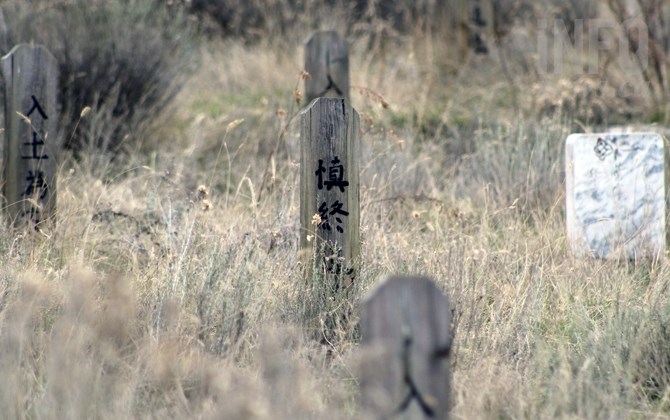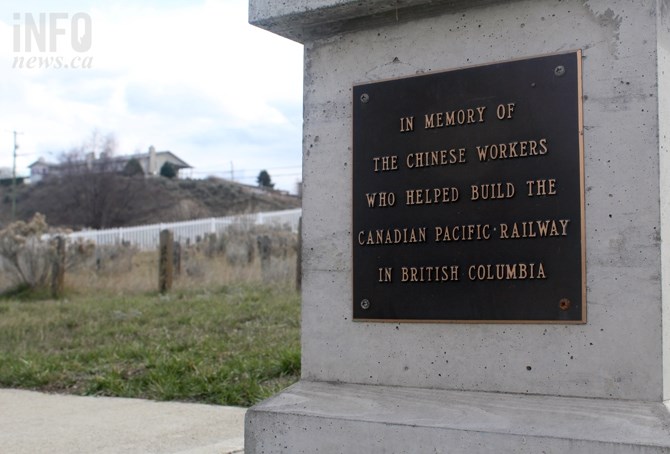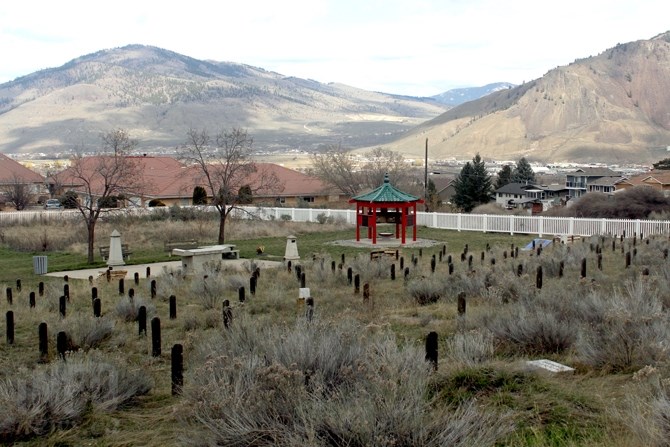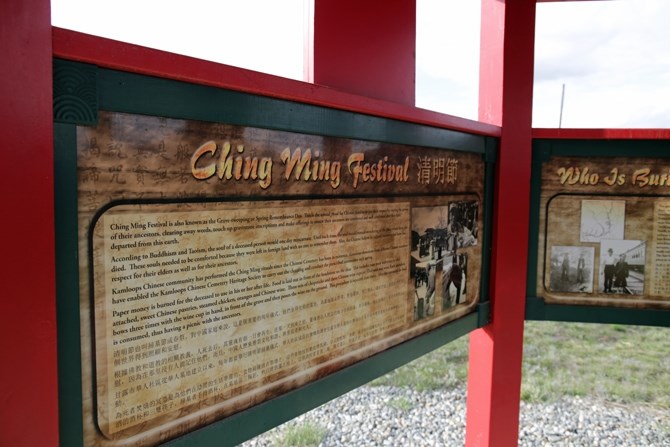
The main gate to the Chinese Cemetery in Kamloops.
(JENNIFER STAHN / iNFOnews.ca)
March 26, 2016 - 11:30 AM
KAMLOOPS - When Chinese Consul-General Liu Fei encouraged Kamloops’s Chinese community to explore and preserve their heritage in the city in 2013, Elsie Cheung went right to work on the most egregious omission — searching for the records from the Chinese Cemetery, the final resting place for many of the community's earliest settlers.
The cemetery is also the final remnant of Kamloops’s historic Chinatown, a once bustling community which made up roughly one-third of the city’s population in 1890. Trouble is since the late 1970s, all the gravemarkers were accidentially removed. After no luck with the city’s records or at the library, Cheung went to the museum and the city’s archives and eventually found burial records from the city’s early days to 1970. She set out to find as much information as she could, going through the pages one at a time to find the lost names.
“I know that the names would be there, it was just to find them,” Cheung says. “I had to sit there. I took pictures. Every time I saw ‘Chinese Cemetery’ I took a picture, then I downloaded them and read over them (later).”
She says it was slow — as a senior she says she's not very good with computers — but the retired nurse, originally from Hong Kong, found 248 names of people buried in the Chinese cemetery. As the president of the Kamloops Chinese Freemason Association, on and off for the past 20 years, it makes sense the task fell to her. The organization has been in Kamloops for more than 100 years, formed from the Chinese Chee Kung Tong organization, Cheung says. Now known as the Chinese Freemason Association, the group is not associated with European Freemasons, but is rather an attempt to make the organization more Canadian with an English name.
The cemetery is an important piece of the city's history many might miss. Cheung says locals may know it exists, tucked up next to Guerin Creek in the city’s West End, just above downtown and the Overlanders Bridge, but probably don’t know its unique history or cultural importance. Cheung says it’s the only Chinese-controlled cemetery in B.C. and her husband George thinks it might be the only one in Canada. She says most other historical burial areas were additions to European settlers graveyards, like in Kelowna, or run by the government, like in Victoria.

Wooden grave markers currently stand in the Chinese Cemetery.
(BRENDAN KERGIN / iNFOnews.ca)
The removal of grave markers was a mistake of cultural ignorance, made when the city took over maintenance of the cemetery. Cheung says when the city came in the late 1970s, they knew it was a cemetery, but not what the markers were.
“They tried to clean up. They didn’t realize they were grave markers,” she says, noting they didn't realize the writing on the markers was names. “They thought it was only a stake. The carving was very faint and in Chinese, so they didn’t understand.”
It’s unlikely the names will be written on grave markers again, Cheung says, because disturbing remains is not allowed by Chinese customs.
“They did say if you dig, there is a glass jar under the stake that had that guy’s name. But we’re not suppose to disturb them,” she says. “It’s too bad we lost all the names.”
The buried now have their names, age and jobs listed nearby, on plaques Cheung and the Kamloops Chinese Freemason Association installed at the cemetery’s gazebo, instead of on the tombstones.
“We know what they did at that time. This is after the gold, after the (railway), they settled down in Kamloops,” she says.
Chinese immigrants first came to British Columbia before it was British Columbia, drawn by the hope of finding gold throughout the Cariboo during the gold rush in the 1860s. When the gold rush ended, new work was available, though not as lucrative, building the Canadian Pacific Railway. Cheung says the cemetery has few women in it, especially early on, because the work attracted single men.

Many of the men buried at the Chinese Cemetery worked on the Canadian Pacific Railway.
(BRENDAN KERGIN / iNFOnews.ca)
The Chinese Cemetery in Kamloops traces its history to then. Many labourers settled in Kamloops once the railway was built. In 1890 it’s estimated one third of the population were Chinese, a community 400-strong living in the town’s west end, according to an academic paper in the Kamloops archives.
The first record of the cemetery comes from a Kamloops Sentinel article from 1897.
“On rambling over the heights overlooking Kamloops… one of the reporters of the Sentinel staff came upon a solitary grave,” the article states. “Our reporter discovered the headboard bearing a Chinese inscription which indicated that a body of a Celestial was buried underneath. We have often wondered where the Chinamen of Kamloops buried their dead; but this solitary grave upon the heights over which cattle tread, seems to unravel much of the mystery.”
The local Chinatown is gone now. Archive records explain how fires took some of it, and the city’s building plans destroyed more. If the buildings still stood, Cheung says they’d be between where the Overlanders Bridge lands on the south bank of the Thompson River and City Hall.
That leaves the cemetery as the last physical remnant of that community. Historical documents say the Chinese community was originally allowed to use the area by the Hudson Bay Company, simply as a place for the dead to be buried temporarily, before being sent back to China to be buried with their ancestors.
In 1892 the land was formally given to the Chinese community specifically for the cemetery.
After the turn of the century the Kamloops cemetery became more important, a permanent resting place for hundreds of people. Transportation of remains back to China became more difficult after the federal government enacted the Chinese Immigration Act in 1923, which hampered immigrants' movement between countries. Cement pillars, a fence, an altar and an incense burner were all erected at the site.
Around the same time, the graveyard would have looked similar to how it is now; a field of wooden boards with carved Chinese characters marking each plot. It was an active cemetery for another 50 years.
“The Lee family is the last one. In 1976, he’s the last one,” Cheung says.

Looking northeast from the Chinese Cemetery in Kamloops.
(BRENDAN KERGIN / iNFOnews.ca)
Even though it has been 40 years since the last person was buried at the site, some families still visit ancestors there, leaving artificial flowers next to some tombstones. About 30 plots have stone markers, though some just have names.
The Kamloops Chinese Freemason Association put new markers in where the city had removed the originals, this time with phrases carved into them, wishing those buried peace and many generations of grandchildren.
Cheung says the site has improved from when she arrived in Kamloops in 1976, when grass regularly overgrew the land. She describes the weeds as having grown to waist height.
“There was no fence, no nothing. No one looked after it,” she says.
“Before Ching Ming we’d come to clean up the grass,” her husband says, referring to the annual spring festival honouring anscetors which traditionally takes place at a cemetery.
The cemetery now has a traditional style gate, a large cement altar and a white picket fence. The gazebo sits on the east side of the property, not great Feng Shui, says Cheung, but more accessible there than up the hill where it probably should be.
The Kamloops Chinese Freemason Association hopes to do much more. Cheung says there are plans to build an archway to commemorate the Chinese legacy, with plaques explaining how the B.C. government treated Chinese immigrants and the official apology issued in 2014.
She’d also like to see a rock garden in the lower half of the cemetery, an area without grave markers.
“We might make it a nice rock garden and then chairs and a walk way. Maybe plants in planters. We might have a few trees, but no watering.”
Cheung even has dreams of a small Chinese community centre one day, for the Chinese Cultural Association and Kamloops Chinese Freemason Association to share, though she says there’s not really a budget for that.

Cement markers will soon replace the wooden grave markers at the Chinese Cemetery.
(JENNIFER STAHN / iNFOnews.ca)
Right now she’s glad to see the progress being made. A donation from a local contractor means the temporary wooden markers will soon be replaced with cement headstones. The stones will have a variety of phrases on them, conferring peace and respect to those buried.
“We try to carry on and keep going. Mainly it’s to carry on the culture and promote our ancestors and all that to the next generation, to (memorialize) all these,” she says about the Chinese culture. “This is history.”
She’s looking to keep engaging the community though, along with the Chinese Cultural Association.
“We formed a new Kamloops Chinese Heritage Cemetery Committee which is under a branch of the cultural association,” she says.
The site was also recently added to a provincial government list of historical places associated with B.C.’s Chinese heritage. As one of 21 sites recently added, Cheung is hopeful that recognition will come with a grant to help with the plans for the cemetery.
In the meantime, she’s going to prepare for Ching Ming. See more about the April festival in Sunday's iNFOnews.ca.

Inside the gazebo at the Chinese Cemetery in Kamloops.
(JENNIFER STAHN / iNFOnews.ca)
To contact a reporter for this story, email Brendan Kergin at bkergin@infonews.ca or call 250-819-6089. To contact an editor, email mjones@infonews.ca or call 250-718-2724.
News from © iNFOnews, 2016